Impact of Trans-Amazonian Highway on Amazon Rainforest: Report
VerifiedAdded on 2021/09/23
|7
|1533
|82
Report
AI Summary
This report delves into the environmental economics of the Amazon rainforest, with a specific focus on the impact of the Trans-Amazonian Highway. It explores the methodology of stated preference, a technique used to assess the non-timber value of forests and evaluate environmental benefits. The report highlights the benefits of the highway, such as connecting regions and alleviating drought effects, while also detailing the significant environmental costs, including deforestation and soil degradation. It examines the financial aspects of the project, including revenue and expenditure, and discusses the advantages and disadvantages of deforestation. The report analyzes the highway's impact, emphasizing the acceleration of deforestation and the long-term environmental costs. It also discusses the advantages of the stated preference method and concludes with the urgent need for interventions to prevent large-scale ecological disaster in the Amazon.
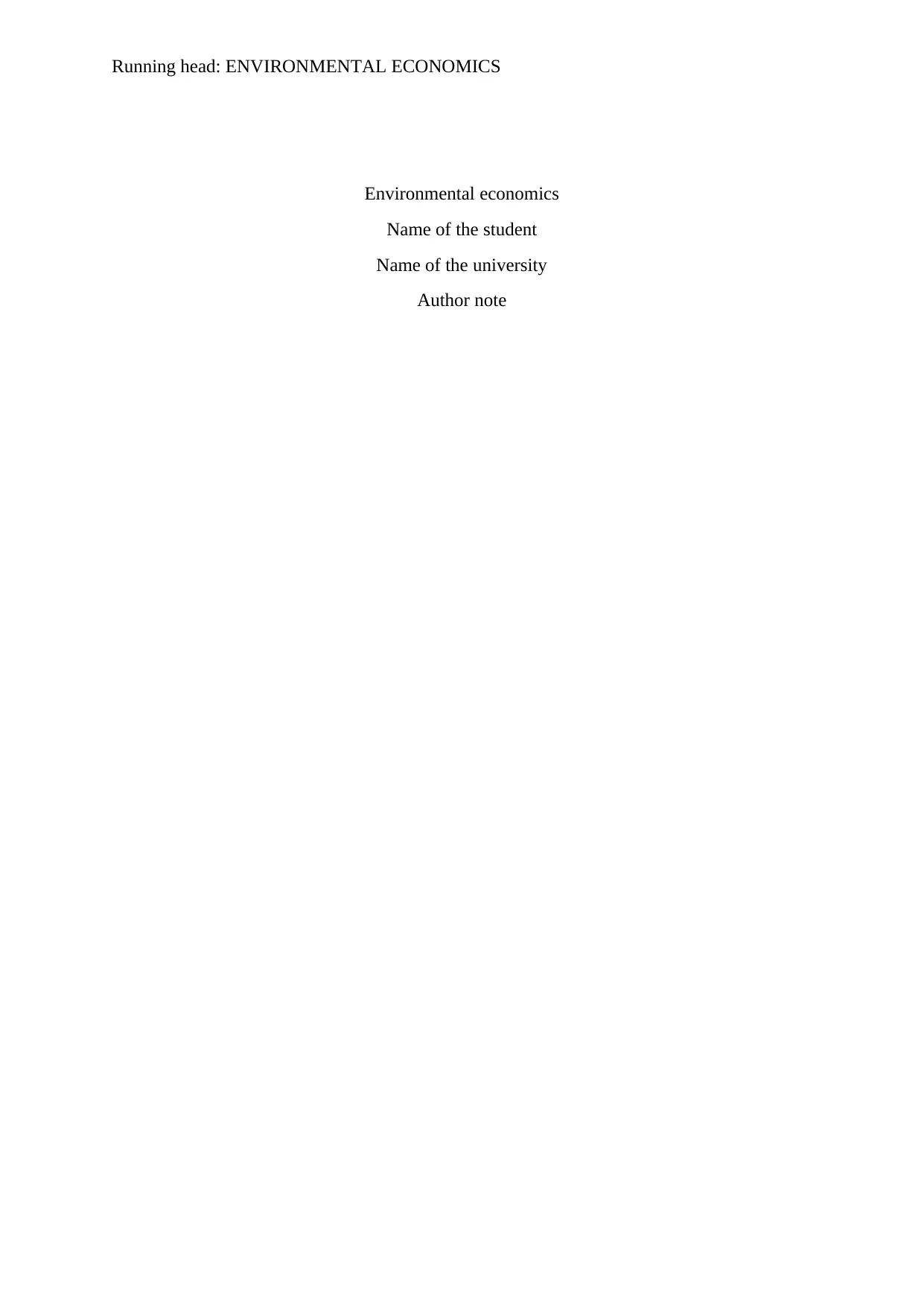
Running head: ENVIRONMENTAL ECONOMICS
Environmental economics
Name of the student
Name of the university
Author note
Environmental economics
Name of the student
Name of the university
Author note
Paraphrase This Document
Need a fresh take? Get an instant paraphrase of this document with our AI Paraphraser
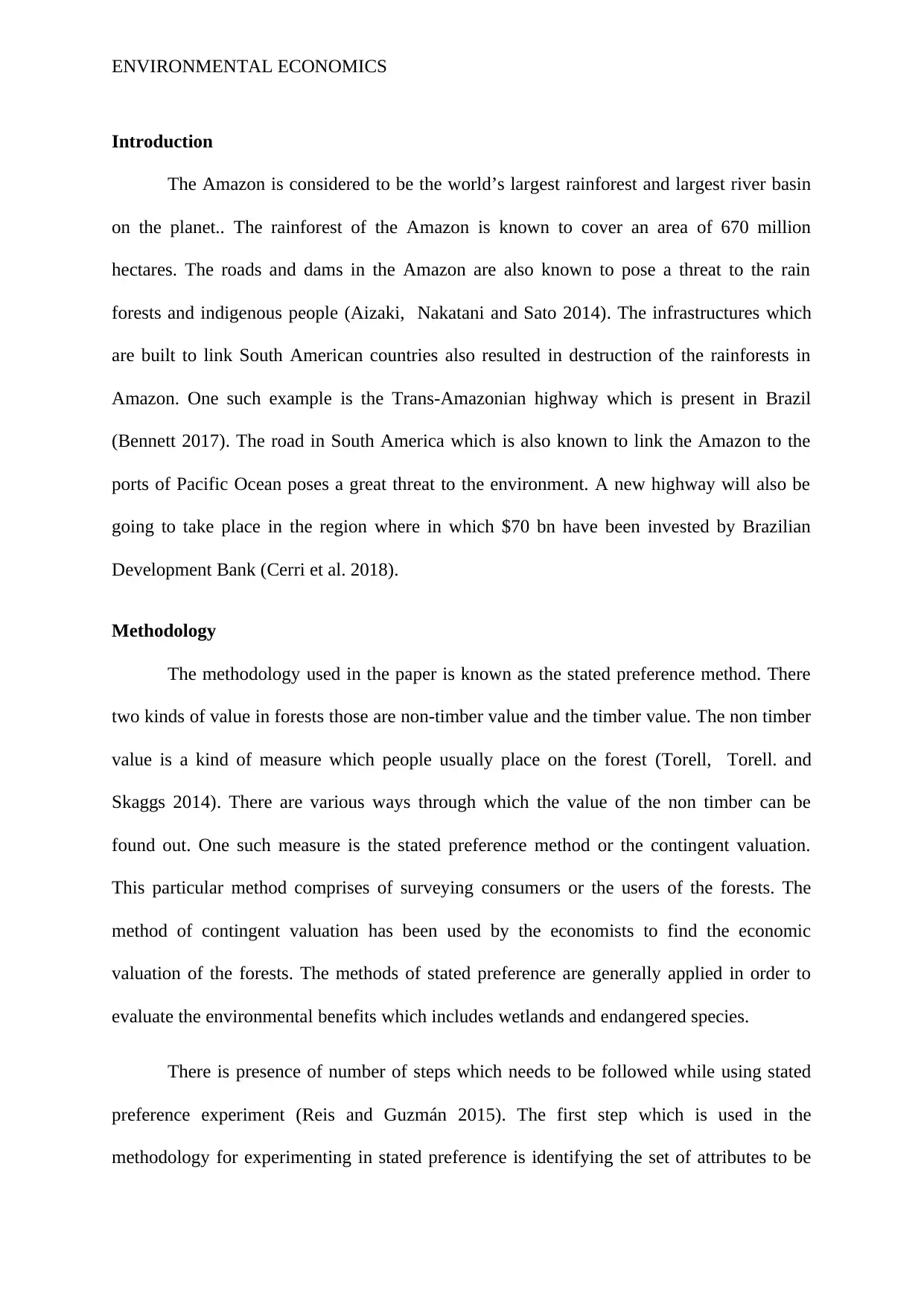
ENVIRONMENTAL ECONOMICS
Introduction
The Amazon is considered to be the world’s largest rainforest and largest river basin
on the planet.. The rainforest of the Amazon is known to cover an area of 670 million
hectares. The roads and dams in the Amazon are also known to pose a threat to the rain
forests and indigenous people (Aizaki, Nakatani and Sato 2014). The infrastructures which
are built to link South American countries also resulted in destruction of the rainforests in
Amazon. One such example is the Trans-Amazonian highway which is present in Brazil
(Bennett 2017). The road in South America which is also known to link the Amazon to the
ports of Pacific Ocean poses a great threat to the environment. A new highway will also be
going to take place in the region where in which $70 bn have been invested by Brazilian
Development Bank (Cerri et al. 2018).
Methodology
The methodology used in the paper is known as the stated preference method. There
two kinds of value in forests those are non-timber value and the timber value. The non timber
value is a kind of measure which people usually place on the forest (Torell, Torell. and
Skaggs 2014). There are various ways through which the value of the non timber can be
found out. One such measure is the stated preference method or the contingent valuation.
This particular method comprises of surveying consumers or the users of the forests. The
method of contingent valuation has been used by the economists to find the economic
valuation of the forests. The methods of stated preference are generally applied in order to
evaluate the environmental benefits which includes wetlands and endangered species.
There is presence of number of steps which needs to be followed while using stated
preference experiment (Reis and Guzmán 2015). The first step which is used in the
methodology for experimenting in stated preference is identifying the set of attributes to be
Introduction
The Amazon is considered to be the world’s largest rainforest and largest river basin
on the planet.. The rainforest of the Amazon is known to cover an area of 670 million
hectares. The roads and dams in the Amazon are also known to pose a threat to the rain
forests and indigenous people (Aizaki, Nakatani and Sato 2014). The infrastructures which
are built to link South American countries also resulted in destruction of the rainforests in
Amazon. One such example is the Trans-Amazonian highway which is present in Brazil
(Bennett 2017). The road in South America which is also known to link the Amazon to the
ports of Pacific Ocean poses a great threat to the environment. A new highway will also be
going to take place in the region where in which $70 bn have been invested by Brazilian
Development Bank (Cerri et al. 2018).
Methodology
The methodology used in the paper is known as the stated preference method. There
two kinds of value in forests those are non-timber value and the timber value. The non timber
value is a kind of measure which people usually place on the forest (Torell, Torell. and
Skaggs 2014). There are various ways through which the value of the non timber can be
found out. One such measure is the stated preference method or the contingent valuation.
This particular method comprises of surveying consumers or the users of the forests. The
method of contingent valuation has been used by the economists to find the economic
valuation of the forests. The methods of stated preference are generally applied in order to
evaluate the environmental benefits which includes wetlands and endangered species.
There is presence of number of steps which needs to be followed while using stated
preference experiment (Reis and Guzmán 2015). The first step which is used in the
methodology for experimenting in stated preference is identifying the set of attributes to be
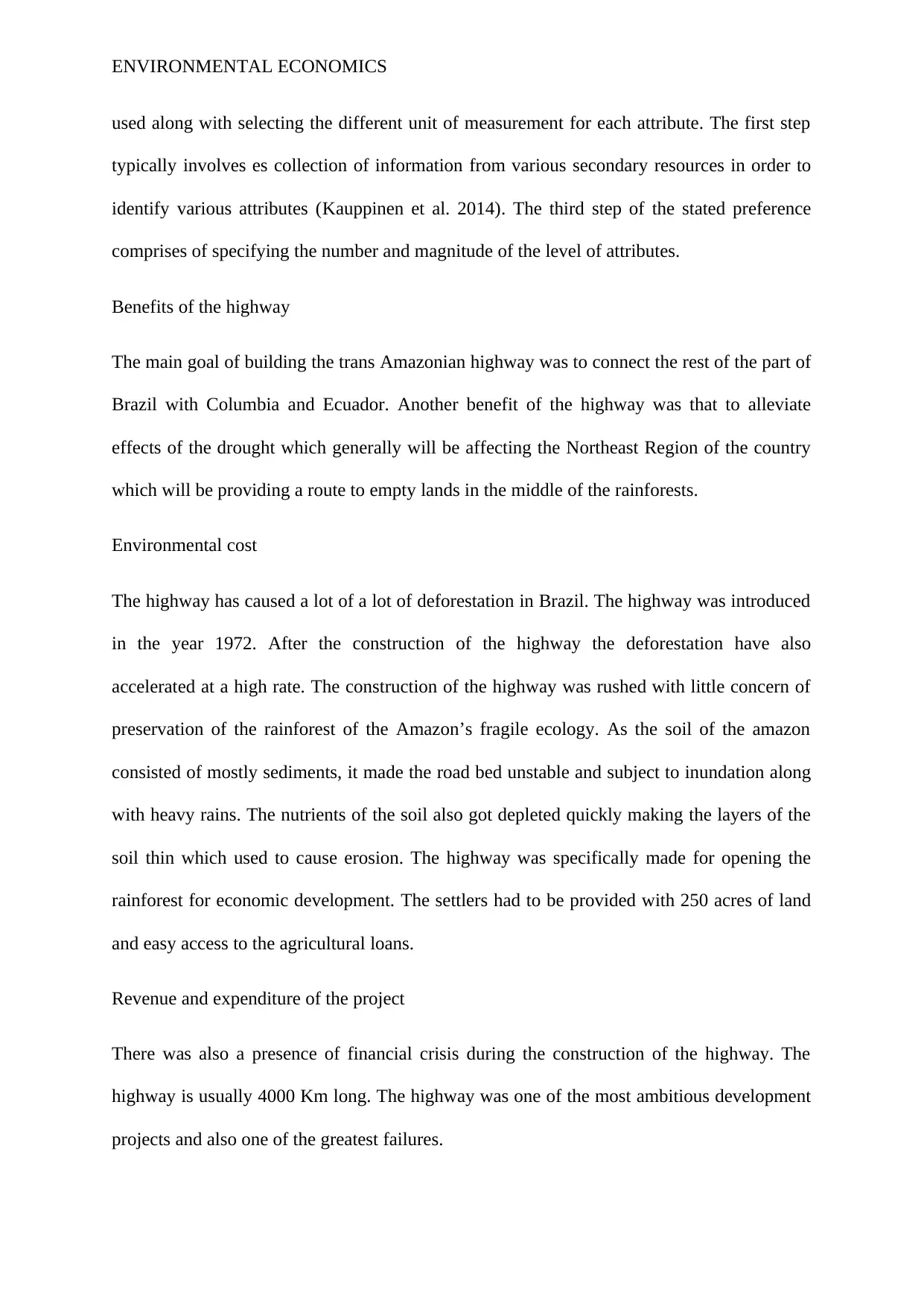
ENVIRONMENTAL ECONOMICS
used along with selecting the different unit of measurement for each attribute. The first step
typically involves es collection of information from various secondary resources in order to
identify various attributes (Kauppinen et al. 2014). The third step of the stated preference
comprises of specifying the number and magnitude of the level of attributes.
Benefits of the highway
The main goal of building the trans Amazonian highway was to connect the rest of the part of
Brazil with Columbia and Ecuador. Another benefit of the highway was that to alleviate
effects of the drought which generally will be affecting the Northeast Region of the country
which will be providing a route to empty lands in the middle of the rainforests.
Environmental cost
The highway has caused a lot of a lot of deforestation in Brazil. The highway was introduced
in the year 1972. After the construction of the highway the deforestation have also
accelerated at a high rate. The construction of the highway was rushed with little concern of
preservation of the rainforest of the Amazon’s fragile ecology. As the soil of the amazon
consisted of mostly sediments, it made the road bed unstable and subject to inundation along
with heavy rains. The nutrients of the soil also got depleted quickly making the layers of the
soil thin which used to cause erosion. The highway was specifically made for opening the
rainforest for economic development. The settlers had to be provided with 250 acres of land
and easy access to the agricultural loans.
Revenue and expenditure of the project
There was also a presence of financial crisis during the construction of the highway. The
highway is usually 4000 Km long. The highway was one of the most ambitious development
projects and also one of the greatest failures.
used along with selecting the different unit of measurement for each attribute. The first step
typically involves es collection of information from various secondary resources in order to
identify various attributes (Kauppinen et al. 2014). The third step of the stated preference
comprises of specifying the number and magnitude of the level of attributes.
Benefits of the highway
The main goal of building the trans Amazonian highway was to connect the rest of the part of
Brazil with Columbia and Ecuador. Another benefit of the highway was that to alleviate
effects of the drought which generally will be affecting the Northeast Region of the country
which will be providing a route to empty lands in the middle of the rainforests.
Environmental cost
The highway has caused a lot of a lot of deforestation in Brazil. The highway was introduced
in the year 1972. After the construction of the highway the deforestation have also
accelerated at a high rate. The construction of the highway was rushed with little concern of
preservation of the rainforest of the Amazon’s fragile ecology. As the soil of the amazon
consisted of mostly sediments, it made the road bed unstable and subject to inundation along
with heavy rains. The nutrients of the soil also got depleted quickly making the layers of the
soil thin which used to cause erosion. The highway was specifically made for opening the
rainforest for economic development. The settlers had to be provided with 250 acres of land
and easy access to the agricultural loans.
Revenue and expenditure of the project
There was also a presence of financial crisis during the construction of the highway. The
highway is usually 4000 Km long. The highway was one of the most ambitious development
projects and also one of the greatest failures.
⊘ This is a preview!⊘
Do you want full access?
Subscribe today to unlock all pages.

Trusted by 1+ million students worldwide
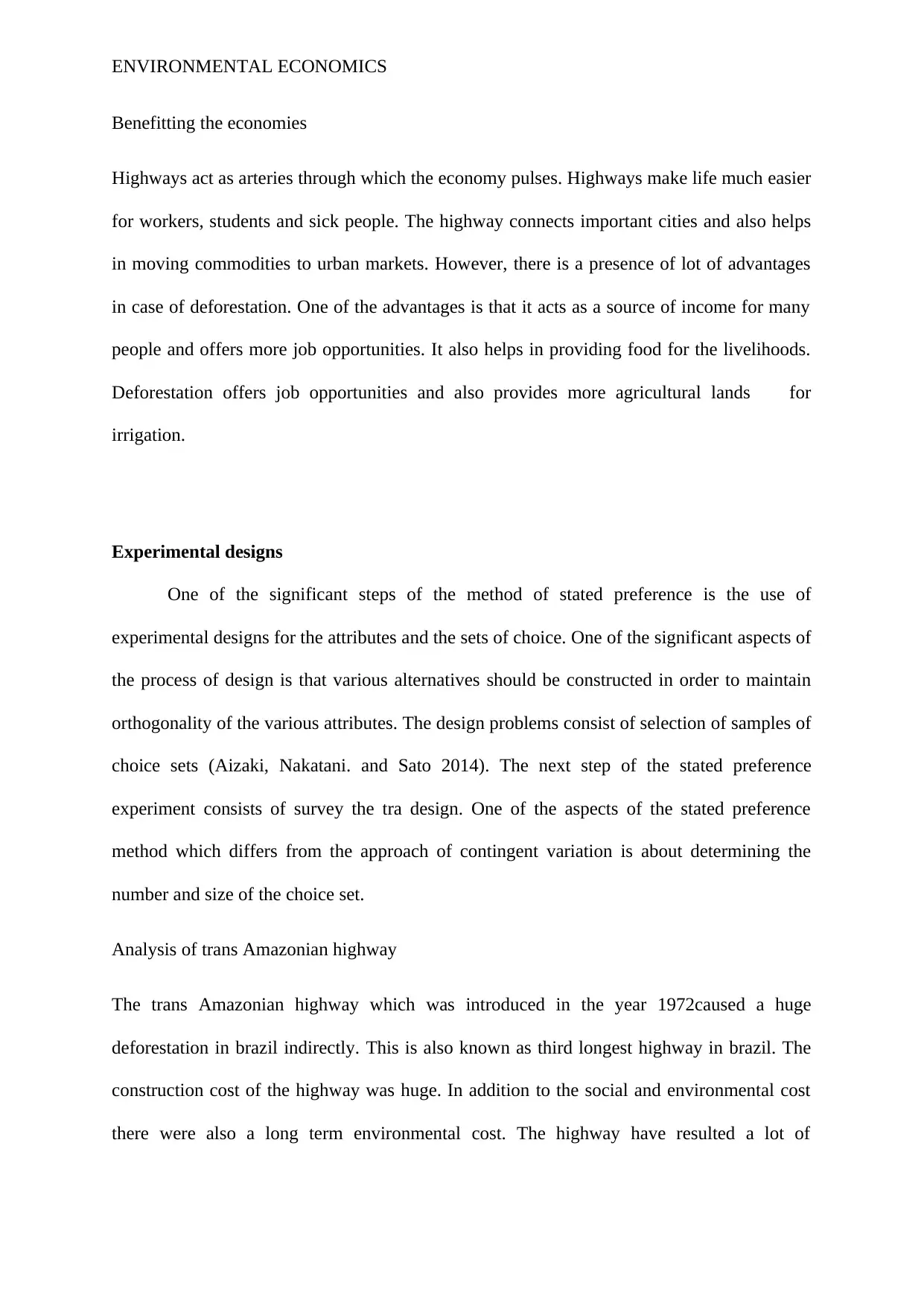
ENVIRONMENTAL ECONOMICS
Benefitting the economies
Highways act as arteries through which the economy pulses. Highways make life much easier
for workers, students and sick people. The highway connects important cities and also helps
in moving commodities to urban markets. However, there is a presence of lot of advantages
in case of deforestation. One of the advantages is that it acts as a source of income for many
people and offers more job opportunities. It also helps in providing food for the livelihoods.
Deforestation offers job opportunities and also provides more agricultural lands for
irrigation.
Experimental designs
One of the significant steps of the method of stated preference is the use of
experimental designs for the attributes and the sets of choice. One of the significant aspects of
the process of design is that various alternatives should be constructed in order to maintain
orthogonality of the various attributes. The design problems consist of selection of samples of
choice sets (Aizaki, Nakatani. and Sato 2014). The next step of the stated preference
experiment consists of survey the tra design. One of the aspects of the stated preference
method which differs from the approach of contingent variation is about determining the
number and size of the choice set.
Analysis of trans Amazonian highway
The trans Amazonian highway which was introduced in the year 1972caused a huge
deforestation in brazil indirectly. This is also known as third longest highway in brazil. The
construction cost of the highway was huge. In addition to the social and environmental cost
there were also a long term environmental cost. The highway have resulted a lot of
Benefitting the economies
Highways act as arteries through which the economy pulses. Highways make life much easier
for workers, students and sick people. The highway connects important cities and also helps
in moving commodities to urban markets. However, there is a presence of lot of advantages
in case of deforestation. One of the advantages is that it acts as a source of income for many
people and offers more job opportunities. It also helps in providing food for the livelihoods.
Deforestation offers job opportunities and also provides more agricultural lands for
irrigation.
Experimental designs
One of the significant steps of the method of stated preference is the use of
experimental designs for the attributes and the sets of choice. One of the significant aspects of
the process of design is that various alternatives should be constructed in order to maintain
orthogonality of the various attributes. The design problems consist of selection of samples of
choice sets (Aizaki, Nakatani. and Sato 2014). The next step of the stated preference
experiment consists of survey the tra design. One of the aspects of the stated preference
method which differs from the approach of contingent variation is about determining the
number and size of the choice set.
Analysis of trans Amazonian highway
The trans Amazonian highway which was introduced in the year 1972caused a huge
deforestation in brazil indirectly. This is also known as third longest highway in brazil. The
construction cost of the highway was huge. In addition to the social and environmental cost
there were also a long term environmental cost. The highway have resulted a lot of
Paraphrase This Document
Need a fresh take? Get an instant paraphrase of this document with our AI Paraphraser
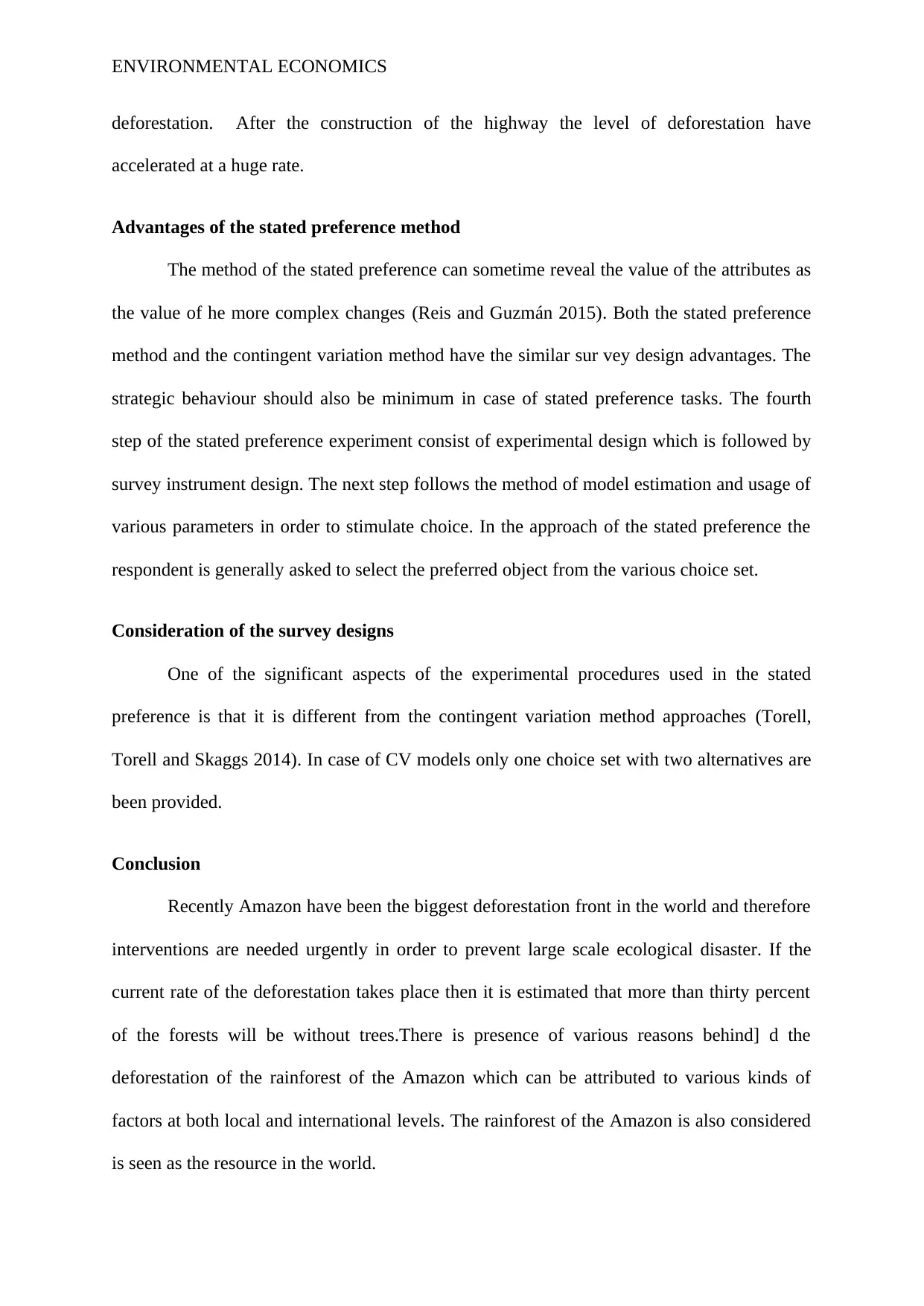
ENVIRONMENTAL ECONOMICS
deforestation. After the construction of the highway the level of deforestation have
accelerated at a huge rate.
Advantages of the stated preference method
The method of the stated preference can sometime reveal the value of the attributes as
the value of he more complex changes (Reis and Guzmán 2015). Both the stated preference
method and the contingent variation method have the similar sur vey design advantages. The
strategic behaviour should also be minimum in case of stated preference tasks. The fourth
step of the stated preference experiment consist of experimental design which is followed by
survey instrument design. The next step follows the method of model estimation and usage of
various parameters in order to stimulate choice. In the approach of the stated preference the
respondent is generally asked to select the preferred object from the various choice set.
Consideration of the survey designs
One of the significant aspects of the experimental procedures used in the stated
preference is that it is different from the contingent variation method approaches (Torell,
Torell and Skaggs 2014). In case of CV models only one choice set with two alternatives are
been provided.
Conclusion
Recently Amazon have been the biggest deforestation front in the world and therefore
interventions are needed urgently in order to prevent large scale ecological disaster. If the
current rate of the deforestation takes place then it is estimated that more than thirty percent
of the forests will be without trees.There is presence of various reasons behind] d the
deforestation of the rainforest of the Amazon which can be attributed to various kinds of
factors at both local and international levels. The rainforest of the Amazon is also considered
is seen as the resource in the world.
deforestation. After the construction of the highway the level of deforestation have
accelerated at a huge rate.
Advantages of the stated preference method
The method of the stated preference can sometime reveal the value of the attributes as
the value of he more complex changes (Reis and Guzmán 2015). Both the stated preference
method and the contingent variation method have the similar sur vey design advantages. The
strategic behaviour should also be minimum in case of stated preference tasks. The fourth
step of the stated preference experiment consist of experimental design which is followed by
survey instrument design. The next step follows the method of model estimation and usage of
various parameters in order to stimulate choice. In the approach of the stated preference the
respondent is generally asked to select the preferred object from the various choice set.
Consideration of the survey designs
One of the significant aspects of the experimental procedures used in the stated
preference is that it is different from the contingent variation method approaches (Torell,
Torell and Skaggs 2014). In case of CV models only one choice set with two alternatives are
been provided.
Conclusion
Recently Amazon have been the biggest deforestation front in the world and therefore
interventions are needed urgently in order to prevent large scale ecological disaster. If the
current rate of the deforestation takes place then it is estimated that more than thirty percent
of the forests will be without trees.There is presence of various reasons behind] d the
deforestation of the rainforest of the Amazon which can be attributed to various kinds of
factors at both local and international levels. The rainforest of the Amazon is also considered
is seen as the resource in the world.

ENVIRONMENTAL ECONOMICS
⊘ This is a preview!⊘
Do you want full access?
Subscribe today to unlock all pages.

Trusted by 1+ million students worldwide
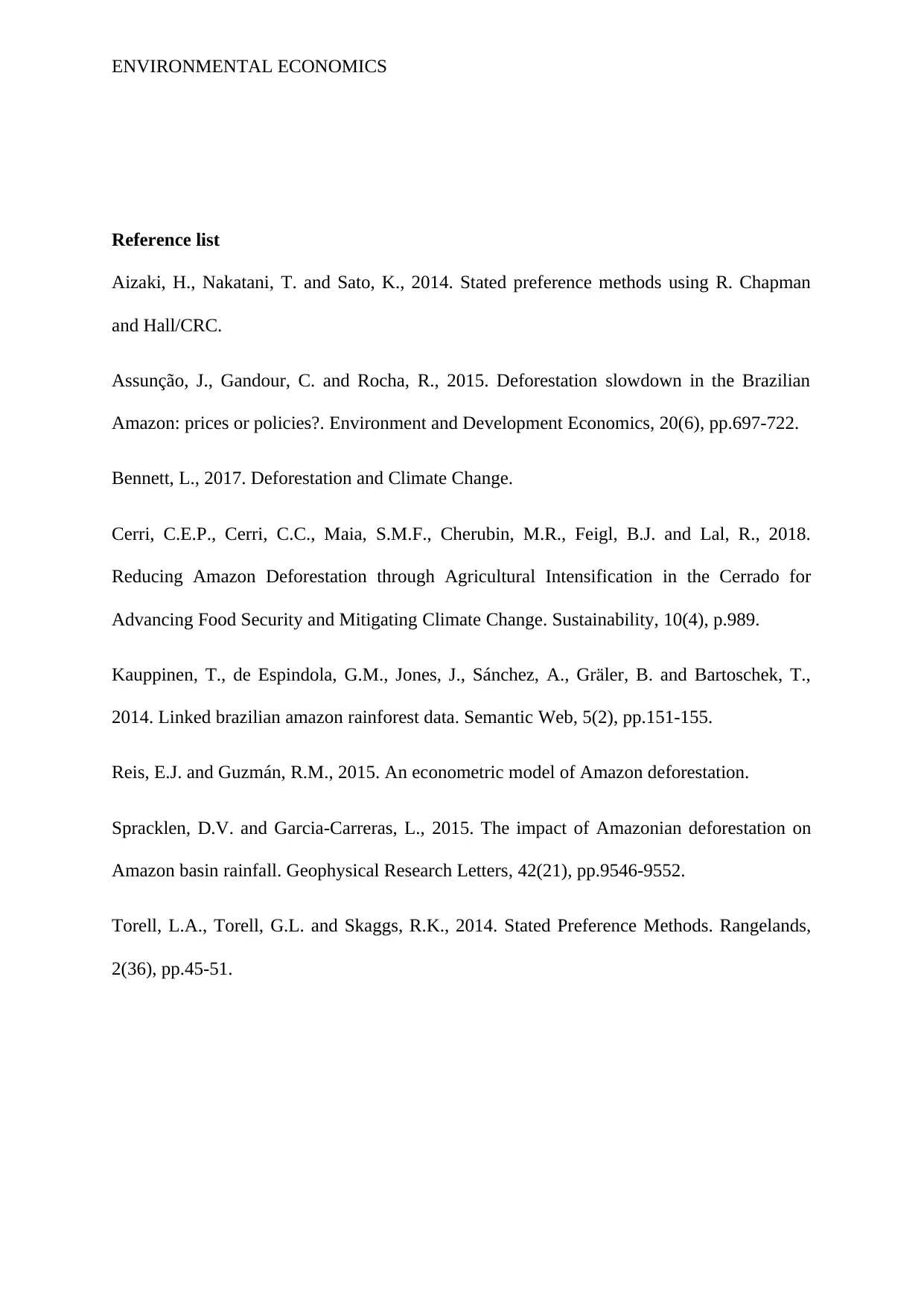
ENVIRONMENTAL ECONOMICS
Reference list
Aizaki, H., Nakatani, T. and Sato, K., 2014. Stated preference methods using R. Chapman
and Hall/CRC.
Assunção, J., Gandour, C. and Rocha, R., 2015. Deforestation slowdown in the Brazilian
Amazon: prices or policies?. Environment and Development Economics, 20(6), pp.697-722.
Bennett, L., 2017. Deforestation and Climate Change.
Cerri, C.E.P., Cerri, C.C., Maia, S.M.F., Cherubin, M.R., Feigl, B.J. and Lal, R., 2018.
Reducing Amazon Deforestation through Agricultural Intensification in the Cerrado for
Advancing Food Security and Mitigating Climate Change. Sustainability, 10(4), p.989.
Kauppinen, T., de Espindola, G.M., Jones, J., Sánchez, A., Gräler, B. and Bartoschek, T.,
2014. Linked brazilian amazon rainforest data. Semantic Web, 5(2), pp.151-155.
Reis, E.J. and Guzmán, R.M., 2015. An econometric model of Amazon deforestation.
Spracklen, D.V. and Garcia‐Carreras, L., 2015. The impact of Amazonian deforestation on
Amazon basin rainfall. Geophysical Research Letters, 42(21), pp.9546-9552.
Torell, L.A., Torell, G.L. and Skaggs, R.K., 2014. Stated Preference Methods. Rangelands,
2(36), pp.45-51.
Reference list
Aizaki, H., Nakatani, T. and Sato, K., 2014. Stated preference methods using R. Chapman
and Hall/CRC.
Assunção, J., Gandour, C. and Rocha, R., 2015. Deforestation slowdown in the Brazilian
Amazon: prices or policies?. Environment and Development Economics, 20(6), pp.697-722.
Bennett, L., 2017. Deforestation and Climate Change.
Cerri, C.E.P., Cerri, C.C., Maia, S.M.F., Cherubin, M.R., Feigl, B.J. and Lal, R., 2018.
Reducing Amazon Deforestation through Agricultural Intensification in the Cerrado for
Advancing Food Security and Mitigating Climate Change. Sustainability, 10(4), p.989.
Kauppinen, T., de Espindola, G.M., Jones, J., Sánchez, A., Gräler, B. and Bartoschek, T.,
2014. Linked brazilian amazon rainforest data. Semantic Web, 5(2), pp.151-155.
Reis, E.J. and Guzmán, R.M., 2015. An econometric model of Amazon deforestation.
Spracklen, D.V. and Garcia‐Carreras, L., 2015. The impact of Amazonian deforestation on
Amazon basin rainfall. Geophysical Research Letters, 42(21), pp.9546-9552.
Torell, L.A., Torell, G.L. and Skaggs, R.K., 2014. Stated Preference Methods. Rangelands,
2(36), pp.45-51.
1 out of 7
Your All-in-One AI-Powered Toolkit for Academic Success.
+13062052269
info@desklib.com
Available 24*7 on WhatsApp / Email
![[object Object]](/_next/static/media/star-bottom.7253800d.svg)
Unlock your academic potential
Copyright © 2020–2025 A2Z Services. All Rights Reserved. Developed and managed by ZUCOL.